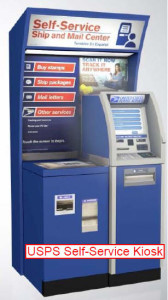OIG Audit report on USPS Self-Service Kiosks(SSKs)
 In fiscal year (FY) 2003, the U.S. Postal Service received approval to develop 2,500 Automated Postal Centers (APCs), now called SSKs. The Postal Service completed distribution of the 2,500 SSKs to about 2,300 post offices in FY 2004. In 2013, the Postal Service deployed an additional 264 SSKs to 132 of the original SSK sites.1 The majority of the SSKs are accessible 24 hours a day; 7 days a week, enabling customers to buy stamps and postal products and to conduct about 80 percent of those transactions normally handled by a retail window clerk (see Figure 1 for example of an SSK). The Postal Service established a customer adoption percentage (CAP) to measure the percentage of walk-in capable transactions performed by SSKs versus those performed by a retail window clerk. This measurement enables the Postal Service to evaluate the effectiveness of SSKs.
In fiscal year (FY) 2003, the U.S. Postal Service received approval to develop 2,500 Automated Postal Centers (APCs), now called SSKs. The Postal Service completed distribution of the 2,500 SSKs to about 2,300 post offices in FY 2004. In 2013, the Postal Service deployed an additional 264 SSKs to 132 of the original SSK sites.1 The majority of the SSKs are accessible 24 hours a day; 7 days a week, enabling customers to buy stamps and postal products and to conduct about 80 percent of those transactions normally handled by a retail window clerk (see Figure 1 for example of an SSK). The Postal Service established a customer adoption percentage (CAP) to measure the percentage of walk-in capable transactions performed by SSKs versus those performed by a retail window clerk. This measurement enables the Postal Service to evaluate the effectiveness of SSKs.
Customers were not using the SSKs as anticipated. The SSKs performed below the 35 percent CAP target for walk-in capable transactions in FY 2013.2 As of June 30, 2013, the SSK performance rate was 26.11 percent, 8.9 percentage points below the FY 2013 nationwide CAP. This condition occurred due to several factors, including inconsistent signage around the SSKs, positioning of some SSKs in partially obscured locations, and lobby assistants (LAs) who were not always trained and used effectively to promote SSK use.3 Increased SSK promotion and use of trained LAs would increase SSK use and eliminate 249,877 retail window workhours, saving about $24 million over 2 years.
The Postal Service also incurred unnecessary SSK supply costs in FY 2012. This occurred due to a software issue that prevented kiosk sensors from determining when all label paper had been used. Some label paper was repurposed or destroyed, which costs about $341,000 annually. The Postal Service began corrective action to address the sensor issue in February 2013. We are not making a recommendation on this issue. In related matters, we provided management with kiosk-related industry strategies and implementation practices.
The SSK audit team visited the following 15 field sites to observe operations and activities related to retail operations and SSK use.The team interviewed managers and asked about their use of LAs. Managers indicated they used employees to greet and assist customers, including LAs, supervisors, and the managers themselves.
We recommended the vice president, Delivery and Post Office Operations, and the vice president, Channel Access, establish a national initiative to train additional lobby assistants, and assess SSK signage and placement. We also recommended deploying lobby assistants to promote and educate customers on SSK usage and eliminate 249,877 workhours to achieve cost savings of about $24 million over 2 years. Finally, we recommended evaluating industry best practices using SSKs and identifying any barriers to implementation.

they dont work for $h!t, always break down and jam
A simple stamp vending machine would be attractive to many customers and cost a fraction of what the SSKs do to purchase and maintain.
Reality is there are to many other means to provide services other than going to a post office. UPS stores provides best customer service and are open at times convenient to customers. The KIOSK concept is a loss. Customer reject using these as there are other convenient
means to accommodate need.
And no one in mgmt. will be held accountable.
As usual.
Just close all the remaining windows and force the customer to use the kiosk; no problem;
Yet *another* money wasting, useless idea from mgmt.
I wonder who’s relative owns the company that makes these ?
What is the difference if you pay a lobby assistant or a window clerk? They both make the same wages and sometimes the lobby assistant is paid way more when a supervisor or manager are doing it. Is the OIG totally brain-dead? People don’t like these machines, period.